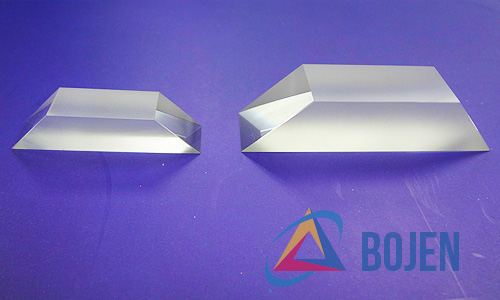| Scratch & Dig: | 80/50~40/20 |
| Flatness: | λ/2~λ/10 |
| Beam Deviation: | 6arc min ~ 5 arc sec |
| Number of Polished Faces: | 3 |
 A Dove prism is used to rotate, invert, or retroreflect an image, depending upon the prism's rotation angle and the surface through which the light enters the prism. Dove Prisms are sold mostly from N-BK7 glass with 5 mm, 10 mm, 15 mm, 20 mm, 25 mm, or 30 mm square cross sections.
A Dove prism is used to rotate, invert, or retroreflect an image, depending upon the prism's rotation angle and the surface through which the light enters the prism. Dove Prisms are sold mostly from N-BK7 glass with 5 mm, 10 mm, 15 mm, 20 mm, 25 mm, or 30 mm square cross sections.
Dove prisms can be thought of as right angle prisms with the triangular apex removed, which reduces the weight of the prism and stray internal reflections. They introduce astigmatism when used with converging light, so we recommend using them with collimated light. Additionally, these prisms affect the polarization state of light transmitted through them.
 Light is usually propagated along the longitudinal axis of a Dove prism. In this geometry , light reflects once from the bottom face, inverting the image on the other side. Rotation of the prism about the longitudinal axis rotates the image at twice the rate of the prism's rotation. For example, a 20° rotation of the prism results in a 40° rotated image.
Light is usually propagated along the longitudinal axis of a Dove prism. In this geometry , light reflects once from the bottom face, inverting the image on the other side. Rotation of the prism about the longitudinal axis rotates the image at twice the rate of the prism's rotation. For example, a 20° rotation of the prism results in a 40° rotated image.
Due to the high incidence angle, the light reflecting from the bottom face undergoes total internal reflection, even if the light's propagation axis and the prism's longitudinal axis are not exactly parallel. Hence, in a Dove prism, the magnitude of the internal transmission is limited only by absorption.
When light is incident on the longest face, the Dove prism acts as a retrorefletor or a right angle prisms. The light exits parallel to the input light (independent of the incidence angle) and is inverted by 180°. In situations with limited space or where more convenient mounting options are needed, the Dove prism can replace a retroreflector or right-angle prism.


